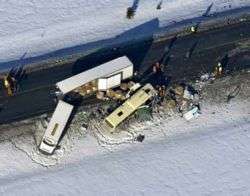Konginkangas bus disaster
The Konginkangas bus disaster was a major traffic accident on March 19, 2004, outside the Konginkangas village in Äänekoski, Finland. At 02:08 local time (00:08 UTC) a bus transporting 38 passengers, most of them youths, to the Rukatunturi skiing center for an alpine skiing vacation crashed into a full-trailer truck carrying heavy paper rolls weighing about 61.5 tonnes (60.5 long tons; 67.8 short tons) total. The accident occurred on highway 4 (E75) 20 kilometres (12 mi) north of Äänekoski, and left the bus driver and 22 passengers dead; 14 were injured. The executive director of the youth travel company was among those who perished in the accident. Most of the victims were immediately killed by the paper rolls ejected into the bus. The truck driver was left unharmed.
 Aerial view of the accident | |
| Date | March 19, 2004 |
|---|---|
| Location | Konginkangas, Äänekoski, Finland |
| Coordinates | 62°46.620′N 25°46.938′E |
| Deaths | 23 |
| Non-fatal injuries | 14 |
Accident
The accident occurred when the trailer of the northbound truck began a soft swerving movement on black ice, which intermittently covered the highway. The trailer first swerved onto the road ramp, then got back on the road and drifted into the lane of oncoming traffic. Despite the evasive attempt by the driver, the trailer continued to run in the opposite lane. A southbound bus then collided with the front wall of the trailer. Five 780-kilogram (1,720 lb) paper rolls were ejected through the front wall of the trailer pushing the wall and paper rolls into the bus at a speed of 70 km/h (43 mph). The winter speed limit on the road was 80 km/h (50 mph). The front of the bus, as well as several seat rows, were demolished on impact.
Investigation
The accident was investigated by the Accident Investigation Board Finland. In total, the Board found 32 causes of the accident. According to the Board, the immediate cause of the accident for the truck driver was the loss of control of the vehicle and the main factors were the choice of an unfavorable route, the high speed of the vehicle and the possible reduced alertness of the driver. In the Board's view, none of the bus passengers wore a seat belt. In the case of the bus driver, the immediate cause was an error of observation which led to a delay in evasion and as a background factor, the high driving speed in snowy weather, which made it difficult to detect the swerving of an oncoming trailer truck earlier on a dark and unlit road. With regard to vehicles, the Board found that they had no technical defects that would have caused the accident. The routes of both vehicles were designed in such a way that it would not have been possible to drive them in compliance with the speed limits in force and the drivers' driving and rest time regulations. In addition, the Board found that the road surface was very slippery and that local slipperiness was difficult to detect and difficult to predict.
The Board issued 17 safety recommendations, the most important of which could be considered to be the transfer of responsibility for transport from the driver alone to all parties involved in the transport. Other notable proposals include lowering the maximum speed limit for truck speed limiters to 80 km / h and using the speed information stored by the tachograph to punish breaches of the speed limit. The Board considered the integrity of the front end of the bus to be insufficient in such an accident, but did not make any recommendations to improve the situation. Instead, Volvo reinforced the front of the body of its 9700 model on its own initiative during 2004.
Trial
The Äänekoski District Court announced its verdict on 31 May 2006. The truck driver was given a suspended sentence of three months' imprisonment for endangering traffic safety, 23 fatalities and three injuries. In addition, the transport company Transpoint was fined a community fine of EUR 10,000 for an occupational safety offense.
The trial continued on 18 December 2006 in the Vaasa Court of Appeal, as the truck driver appealed against the verdict. A few interested parties also expressed dissatisfaction with the verdict of the Äänekoski District Court, but none of them ultimately appealed.
On 23 January 2007, the Court of Appeal upheld the District Court's decision largely unchanged. The truck driver did not appeal the verdict to the Supreme Court, so the verdict of the Court of Appeal remained final.
References
- Lähteenmäki, Esko; et al. (2006) [2005]. A head-on collision involving a heavy vehicle combination and a charter coach on highway 4 at Konginkangas near the town of Äänekoski, Finland on 19.3.2004 (PDF). Investigation report A 1/2004 Y. trans. R&J Language Service (Abridged translation of the original Finnish report ed.). Helsinki: Accident Investigation Board Finland. ISBN 951-836-176-2. ISSN 1239-5315. OCLC 141380775. Retrieved July 18, 2007.
Further reading
- Citec Information (2005). "Konginkangas 19.3.2004 klo 02:08 (animation)" (in Finnish). Accident Investigation Board Finland. Retrieved May 27, 2007.
- "At least 23 dead in bus crash in Central Finland". Helsingin Sanomat International Edition. March 19, 2004. Archived from the original on 2007-09-30. Retrieved May 27, 2007.
- "Excessive speed and driver error seen as causes of collision killing 23 last year". Helsingin Sanomat International Edition. November 18, 2005. Retrieved May 27, 2007.
- "Suspended sentence for truck driver in Konginkangas disaster". Helsingin Sanomat International Edition. June 1, 2006. Retrieved May 27, 2007.